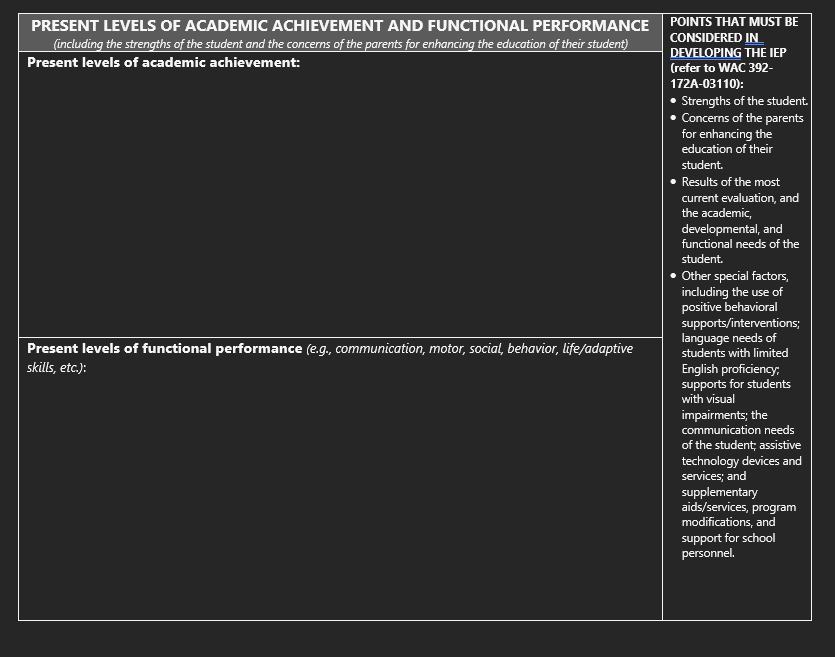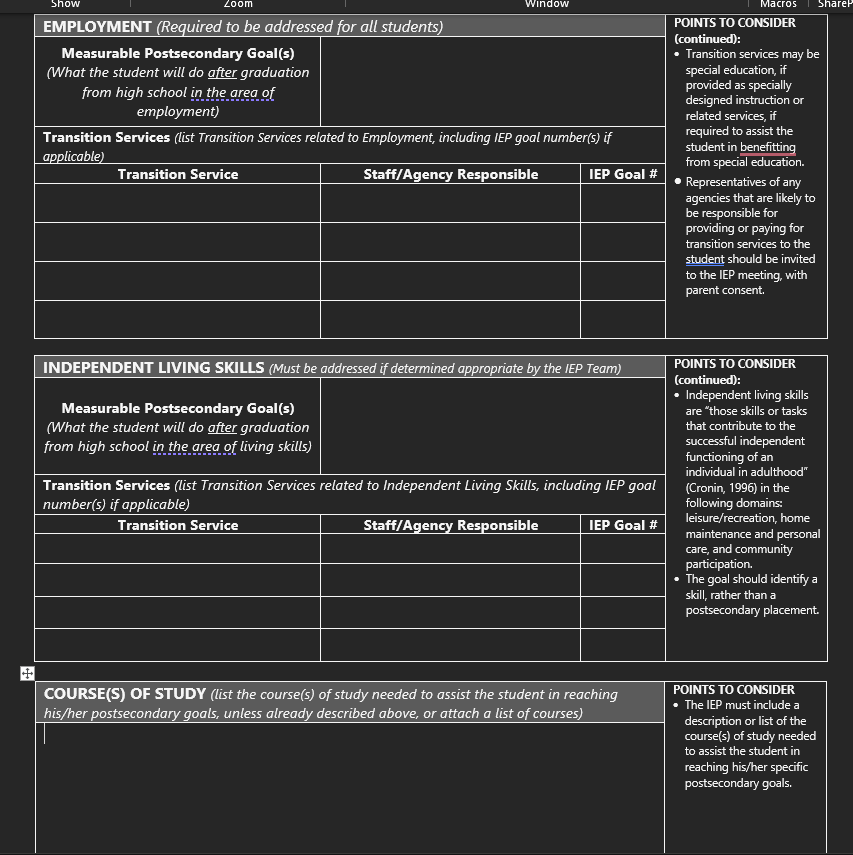How to Write an IEP

How to Write a Quality IEP
An Individual Education Program, more commonly known as an IEP, is an education program for students with disabilities that significantly impact their learning. IEPs contain a student’s present levels of performance, annual goals, modifications to their curriculum, accommodations, and additional services provided to support student success. If the student is 16 or older, their IEP will also contain a transition plan, which is a plan for what the student will be doing after high school, whether that’s attending college or going into job training. These components must be as accurate, detailed, and specific as possible to provide access to the free, appropriate, public education students with disabilities are entitled to. These instructions will help you write, edit, and update a student’s IEP properly.
Gather Data

- Retrieve classroom data. Get your student’s data that you and your paraeducators/paraprofessionals have gathered throughout the calendar year.
- Academic data
- Social-emotional data
- Behavior data
- Contact other parties involved in your student’s education to retrieve additional data. People outside of your classroom who work with your student will have their data on that student.
- Specialists such as speech pathologists, school psychologists, and occupational therapists will have functional data.
- General education teachers will have data on your student for when they are in the general education classroom.
- Families, guardians, and caregivers will have testimonies and possible data that will be helpful for setting goals, making modifications to the student’s curriculum, and implementing any accommodations needed.
Complete the Present Levels of Academic Achievement and Functional Performance (PLAAFP) Section
.png)
- Write your student’s expiring goal. Write the goal and whether they’ve achieved it or not.
- If the student has achieved or is close to achieving the expiring goal, you must write a new goal based on the data you’ve gathered throughout the calendar year in the Measurable Annual Goals section.
- If your student hasn’t achieved the goal, that goal will be kept for the next calendar year if appropriate.
- If your student hasn’t achieved the goal and based on the data, they won’t be able to within the next calendar year, you must write a new goal based on the data you’ve collected throughout the calendar year in the Measurable Annual Goals section.
- Write your student’s strengths in the subject of the expiring goal. Use the data you’ve collected on your student throughout the calendar year to summarize their strengths within the subject of the expiring goal. Subjects of goals are but aren’t limited to:
- Math
- Reading
- Writing
- Social-emotional
- Adaptive skills
- Communication/Speech
- Write your student’s current skills and challenges related to the subject of the expiring goal. Use the quantitative and qualitative data you’ve collected on your student throughout the calendar year to summarize their skills and challenges related to the subject of the expiring goal at this time.
- Quantitative data is the numbers in the data you’ve collected throughout the calendar year.
- Qualitative data is the narrative data you’ve collected throughout the calendar year.
- Write any testimonials from the IEP team regarding your student’s current strengths and challenges regarding the subject of the expiring goal. Include any relevant input from all parties involved in the IEP team, including but not limited to:
- Family/guardian
- Caregiver(s)
- General education teacher(s)
- Specialists such as the speech pathologist, school psychologist, and occupational therapist
- Write the impact on general education. Include the impact of your student’s challenges in relation to the expiring goal objectively.
- Write a baseline for the new goal.
- Format: [STUDENT NAME] can insert goal here.
- Repeat this section for all expiring goals.
Write Your Student's Measurable Annual Goals (MAGs)
.png)
- Write your student’s MAGs in each subject necessary. These goals are based on the data collected on your student throughout the last calendar year.
- Format: When given ___________, [STUDENT NAME] will ___________________ from _________ to ___________ as measured by _____________________
- Do this for every subject that your student needs to have a MAG in, based on the data collected throughout the calendar year.
- Any specialist your student works with will write their own goals for your student, such as speech and motor skills.
- Write 3 short-term objectives for each MAG. Each goal needs to have at least 3 benchmarks or short-term objectives throughout the calendar year to keep track of student progress towards their annual goal.
- Format: By insert date, [STUDENT NAME] will insert benchmark here.
- Any specialist your student works with will write their own benchmarks and short-term objectives for your student, such as speech and motor skills.
Fill in the Checklist Sections As Appropriate
.png)
.png)
.png)
- Check yes in each box for the services your student needs. In the Consideration of Special Factors section, check yes or no based on the data collected throughout the last calendar year.
- Write any additional information necessary in the If yes, describe boxes on the right side of the page in the appropriate columns.
- If your student has a Behavior Intervention Plan (BIP), check the box next to A Behavior Intervention Plan has been developed for this student.
- Check the boxes according to which state or district-wide assessments your student will participate in.
- Check the English/Language Arts, Math, and Science boxes according to the assessment your student will take in those subjects.
- List any other assessments your student will take within the calendar year in the Other statewide assessments and Districtwide assessments sections.
- List any and all accommodations your student will need while taking any of the assessments listed.
- If your student must be excluded from participation in state and district-wide assessments, write an explanation as to why in the box below the Accommodations box.
- Write the letters that correlate with each subject your student needs the listed accommodation for. For each subject your student needs accommodations in, put the letter associated with that subject in the box next to the listed accommodation.
- The legend for the subjects is at the bottom of the Modifications and Accommodations page.
- If your student needs an accommodation that is not listed, write it in one of the Other boxes on the page. Input the letter of the subject in the box next to the written accommodation.
For Students 16 and Older: Write or Update Their Transition Plan
.png)
.png)
- List any and all assessments your student has taken relating to their transition plan. If you have data from any assessment that your student has taken in relation to their transition plan, write it in the Age Appropriate Transition Assessments box.
- Examples of assessments: surveys, portfolios, interviews, vocational assessments
- Write Measurable Post-Secondary Goals (MPSGs). Write as many MPSGs as appropriate based on the data collected from the transition assessments your student has taken.
- MPSGs will be written in the same format as the MAGs you’ve written in the Measurable Annual Goals section of the IEP.
- MPSG sections: Education/training, employment, and independent living skills
- Any specialist your student works with may have their own MPSGs for your student. They will write those goals as appropriate.
- Include any transition services that will assist your student in their MPSGs.
- Agencies involved in transition services may reach out to you regarding your student’s transition plan.